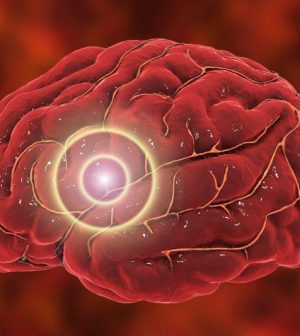- Navigating Your Midlife Crisis: Embracing New Possibilities
- City Raccoons Showing Signs of Domestication
- Mapping the Exposome: Science Broadens Focus to Environmental Disease Triggers
- One Week Less on Social Media Linked to Better Mental Health
- Your Brain Changes in Stages as You Age, Study Finds
- Some Suicide Victims Show No Typical Warning Signs, Study Finds
- ByHeart Formula Faces Lawsuits After Babies Sickened With Botulism
- Switch to Vegan Diet Could Cut Your Greenhouse Gas Emissions in Half
- Regular Bedtime Does Wonders for Blood Pressure
- Dining Alone Could Mean Worse Nutrition for Seniors
Brain Zaps Can Make Folks More ‘Hypnotizable’

An electrical zap to the brain can temporarily render a person more susceptible to hypnosis, a new study shows.
Participants became more easily hypnotized after paddles placed against their scalp delivered two 46-second rounds of electrical pulses to a precise location in their brain, researchers reported Jan. 4 in the journal Nature Mental Health.
This increase in their susceptibility to hypnosis lasted for about an hour, results show.
These findings could make hypnotherapy a viable treatment for people who otherwise couldn’t be deeply tranced, the researchers said.
“We know hypnosis is an effective treatment for many different symptoms and disorders, in particular pain,” said lead researcher Afik Faerman, a postdoctoral scholar in psychiatry at Stanford Medicine. “But we also know that not everyone benefits equally from hypnosis.”
About two-thirds of adults are at least somewhat prone to hypnosis, and 15% are considered highly hypnotizable, researchers said in background notes.
“Hypnosis is a state of highly focused attention, and higher hypnotizability improves the odds of your doing better with techniques using hypnosis,” senior researcher Dr. David Spiegel, a professor of psychiatry and behavioral sciences at Stanford, said in a university news release.
Spiegel has studied hypnotherapy for decades, using it to help patients control pain, lower stress and stop smoking.
Up to now, hypnotizability has seemed to be a stable trait in people that changes little as they grow older, akin to personality and IQ, the researchers said.
For example, an earlier study of Stanford University students found that their susceptibility to hypnosis remained as consistent as their IQ over a 25-year period, researchers noted.
But several years ago, another study led by Spiegel found that highly hypnotizable people had stronger connections between two specific regions of the brain — the left dorsolateral prefrontal cortex, which is involved in information-processing and decision-making, and the dorsal anterior cingulate cortex, which is involved in detecting stimuli from the environment.
“It made sense that people who naturally coordinate activity between these two regions would be able to concentrate more intently,” Spiegel said. “It’s because you’re coordinating what you are focusing on with the system that distracts you.”
Given that finding, researchers wondered whether electrical stimulation aimed at this hypnosis-related brain connection could alter a person’s susceptibility to trance.
In their new study, researchers recruited 80 patients with fibromyalgia, a chronic pain condition that can be treated with hypnotherapy. The team specifically excluded people who already were highly hypnotizable.
Half of the patients received transcranial magnetic stimulation, in which paddles sent electrical pulses into a precise location in their left dorsolateral prefrontal cortex.
The exact location targeted by the pulses depended on the unique structure and activity of each person’s brain, researchers said.
“A novel aspect of this trial is that we used the person’s own brain networks, based on brain imaging, to target the right spot,” said senior researcher Dr. Nolan Williams, an associate professor of psychiatry and behavioral sciences at Stanford.
Patients who received the brain stimulation underwent a statistically significant increase in hypnotizability, researchers found.
“We were pleasantly surprised that we were able to, with 92 seconds of stimulation, change a stable brain trait that people have been trying to change for 100 years,” Williams said. “We finally cracked the code on how to do it.”
This temporary boost in hypnotizability could help patients manage chronic pain with hypnosis rather than opioids, the researchers said.
Electrical stimulation to the brain might also enhance people’s response to other forms of psychotherapy, they added.
“As a clinical psychologist, my personal vision is that, in the future, patients come in, they go into a quick, noninvasive brain stimulation session, then they go in to see their psychologist,” Faerman said. “Their benefit from treatment could be much higher.”
More information
Johns Hopkins Medicine has more about hypnosis.
SOURCE: Stanford Medicine, news release, Jan. 4, 2024
Source: HealthDay
Copyright © 2025 HealthDay. All rights reserved.










